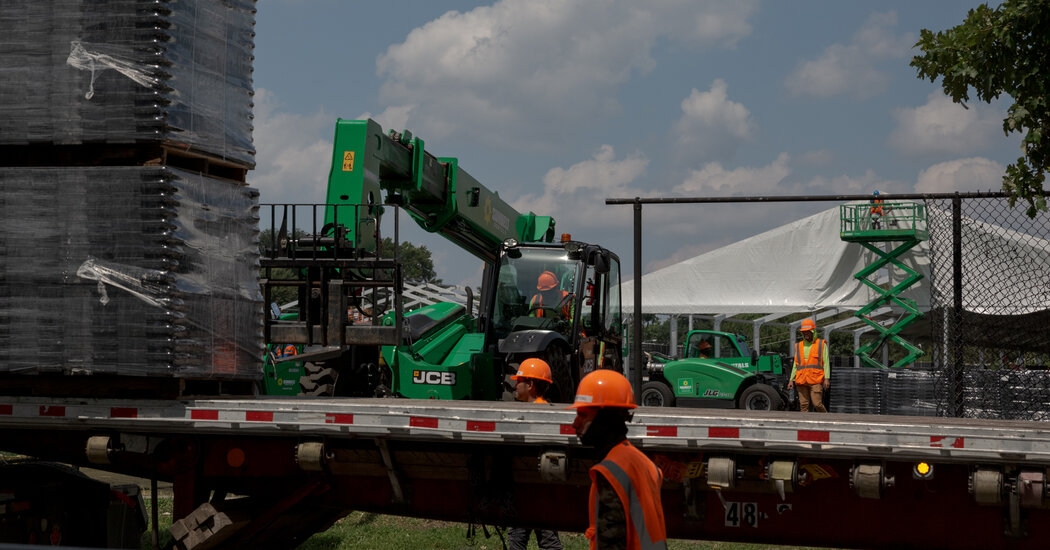
New York’s Right to Shelter Is Under Attack. Again.
On Tuesday night, the City of New York filed court documents asking to get out of an obligation it has maintained, if not happily or even willingly, for more than 40 years. The matter at hand was the 1981 consent decree that has come to be known as right to shelter, the result of a lawsuit that successfully sought to require the city to provide a bed to any homeless man who asked for one.
In light of the migrant crisis, which has put roughly 117,000 mostly jobless, struggling and traumatized people under the city’s stewardship, the Adams administration was formally expressing the grievance it has aired for months — that the city, having already opened 210 emergency sites and spent more than $2 billion, had reached the limit of its largess.
Officials were asking for a temporary suspension of the mandate, during designated emergencies, specifically in regard to single adults — not families with children, which might seem inconceivably heartless — on the grounds that resources have been exhausted. Exhaustion itself, though, is not a sufficient basis for a legal argument, so the complaint, now in the hands of the New York Supreme Court, rests largely on the assertion that the right-to-shelter decree constrains the city’s “flexibility” to handle the crisis.
How exactly the city would proceed if it were not legally required to comply remains unclear. The argument is confounding because the city has already relaxed so many of the rules related to accommodating homeless men and women, and advocates, recognizing the exceptional circumstances created by the influx of so many displaced people to the city, have not mounted significant challenges. “All the things in the decree about what a shelter should look like — how many feet there ought to be between beds — are out the window,” Joshua Goldfein, staff attorney at the Legal Aid Society, told me.
To its credit, the city has acted impressively under an extraordinarily difficult set of logistics. With the goal of freeing up space in crowded shelters, Mayor Eric Adams last week announced an expansion of a housing voucher program that would allow New Yorkers stuck in the shelter system to apply a city-administered subsidy toward rent anywhere in the state. Previously, the subsidy had to be used within the five boroughs.
An organization of rural and suburban counties immediately objected, which suggests that the problems lie less with whatever barriers might exist to exercising bureaucratic innovation and more with the reluctance of other local governments to help. Gov. Kathy Hochul could override this kind of resistance but hasn’t shown an interest in expending the political capital to do it. In an address a few weeks ago, she put things bluntly: “We cannot and will not force other parts of our state to shelter migrants.”
Progressives have worried about the potential gutting of right to shelter since the first busloads of migrants arrived from the border last year. That fear has long historical precedent. Over the past decades, right to shelter has been challenged dozens of times, but the courts have consistently opted to preserve it. Some of the most aggressive attacks came during the Giuliani and Bloomberg years, when, for instance, an effort to kick families out of shelter for not following certain bureaucratic rules and place their children in foster care was shot down.
The decree has its roots in the late 1970s, when Robert Hayes, a young associate at Sullivan & Cromwell, the patrician Wall Street law firm, noticed homelessness all around him as the prosperity that had distinguished New York in the postwar period ended. Between 1965 and 1977, more than 100,000 patients had been released from state psychiatric hospitals, nearly half of whom landed on the streets of Manhattan.
Living downtown, Mr. Hayes, who would go on to found the National Coalition for the Homeless and receive a MacArthur fellowship, met men camped out in Washington Square and in the flophouses that lined the Bowery, where the conditions were terrible and the ceilings were made of chicken wire. He was moved by their stories. Confident that local government would not respond to the unraveling as a matter of moral calling, Mr. Hayes saw litigation as the only way forward.
He found his lead plaintiff at the Holy Name Center for Homeless Men on Bleecker Street. He was a middle-aged former short-order cook named Robert Callahan who drank himself into vagrancy. Though his friends in the Catholic Worker movement thought a lawsuit should focus on Cardinal Terrence Cooke, because so many of the flophouses were run by the Church, Mr. Hayes, more ambitiously, took on the mayor and the governor.
He argued that a clause in the state constitution stipulating that the “aid, care and support of the needy” were public concerns meant that homeless men were legally entitled to shelter. He prevailed, and the consent decree was signed in August of 1981, by which point Robert Callahan had already been found dead on Mott Street. Subsequent litigation established the same right for women and then, eventually for families with children.
The Hayes cause benefited from the narrow understanding of emerging social realities held by the city’s legal team and its advisers. As the case moved along, advocates argued for 750 beds to be set aside. Assuming that this was a brash overestimate, the city answered that shelter space should be allocated on an as-needed basis. Almost immediately after the decree was signed, it was clear that the need ran much higher. Advocates were back in court by the fall fighting for more beds.
“I don’t think they understood their own system,” Kim Hopper, a medical anthropologist at Columbia University, told me. The lowest-rung civil servants, he pointed out, were shunted to shelter services. His work on homelessness and testimony in the Callahan case proved crucial. When lawyers for the city recognized that they were likely to lose, they decided to settle. What the city gained was a greater control over shelter placement and the ability to keep shelters out of neighborhoods where they might produce the most backlash.
Even now, though, an understanding of homelessness among seasoned Democratic politicians is often deficient. Echoing Governor Hochul, Bill Clinton, in a radio interview recently, stressed the need for migrants to get work permits quickly as the clearest means to a solution. However necessary that might be, it ignores the fact the 40 percent of the city’s homeless population is employed.
Revoking the right to temporary housing will not make migrants disappear. Instead, it will leave them settling in public space, building the encampments that have unwound cities like Los Angeles and San Francisco, where there is no similar covenant guaranteeing shelter. It is hard to imagine who would prefer that outcome.




